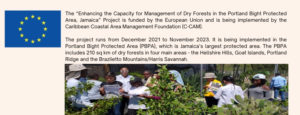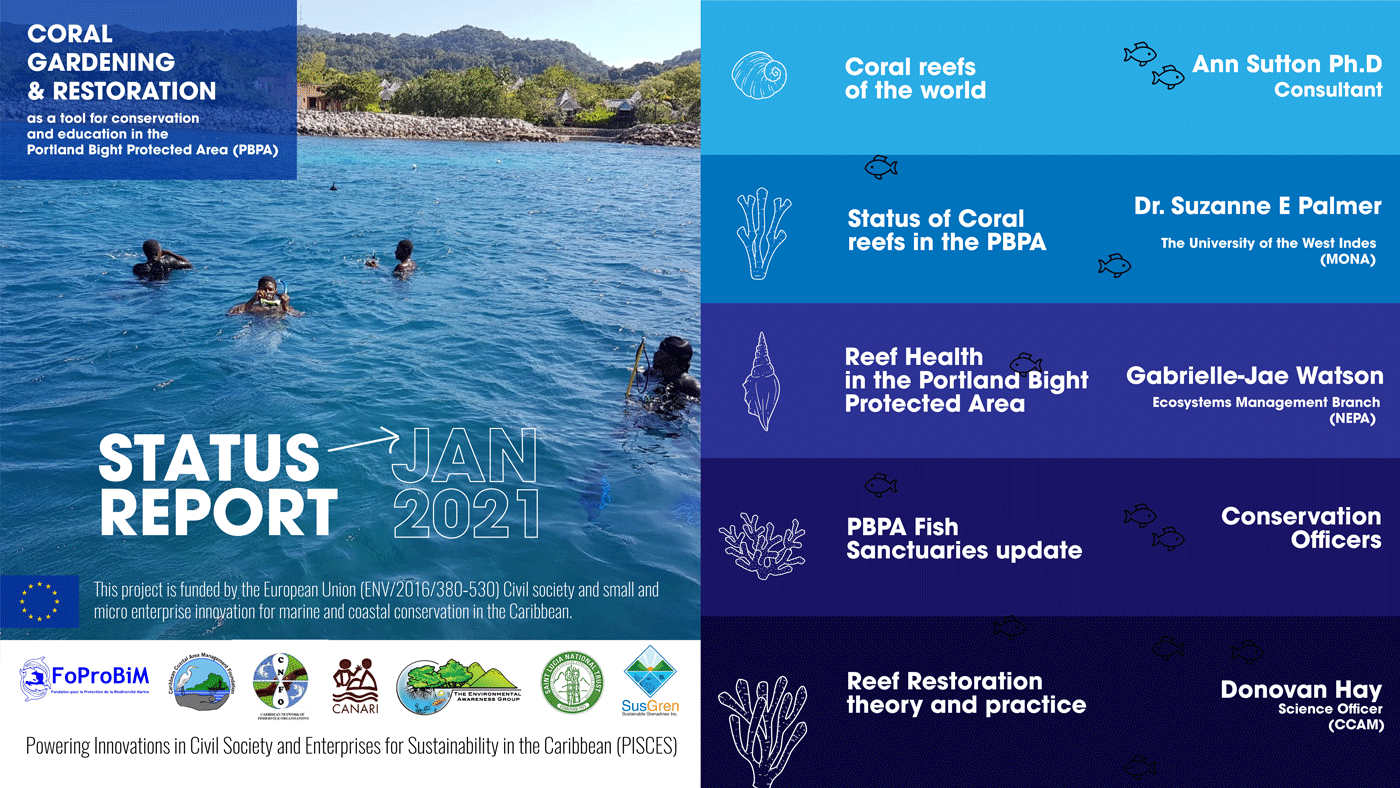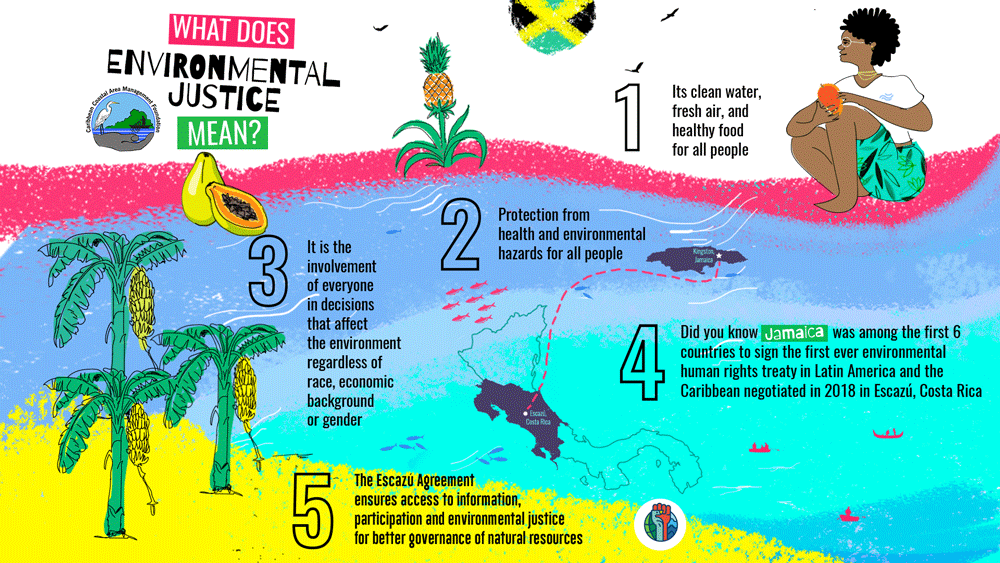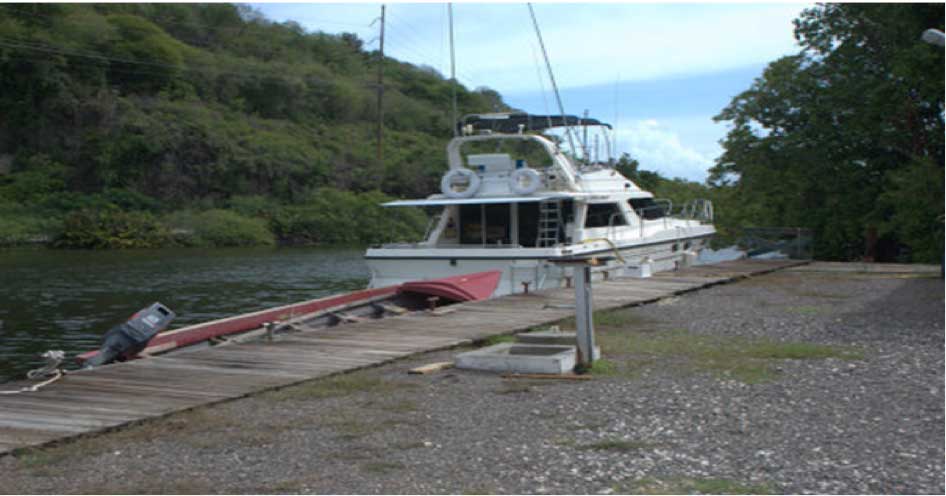C-CAM manages the following projects designed to protect and conserve the Portland Bight.
-
The “Enhancing the Capacity for Management of Dry Forests in the Portland Bight Protected Area, Jamaica” project aims to:
1. Enhance C-CAM’s capacity to manage, protect and monitor dry forests of the Portland Bight Protected area (PBPA).
2. Collect and manage data on the status of dry forests and their biodiversity
3. Improve Education and Outreach about dry forests and dry forest conservation in at least three communities
4. Coordinate conservation actions in communications through the establishment of the Forest Conservation Council in the PBPA

- Coral Gardening & Restoration

Coral Gardening & Restoration Project Goal
To support conservation and restoration of the marine ecosystems of the PBPA and to increase community support for (Ecosystem Based Management) EBM by improving awareness and engagement.
Project objectives
Objective 1
Increase capacity for coral reef restoration by 75% by 31 September 2020 by increasing the number of coral trees from one to a minimum of four units expanding the area of the coral nursery, and out-planting a minimum of 500 corals to nearby natural and artificial reefs
6 Activities under Objective 1:
- Host training and planting workshop for C-CAM staff, fishers and other volunteers in coral out-planting
- Expand physical aspects of nursery site
- Collect corals for expanded nursery site
- Plant corals in expanded nursery site
- Monitor/maintain expanded nursery site
- Record activities through videos and photography and use them on social media
Objective 2
Engage a minimum of 100 Portland Bight fisherfolks from at least six of the eight PBPA beaches in the marine EBM awareness or implementation activities.
6 Activities under Objective 1:
- Design coral reef restoration and ecology education and awareness programme
- Implement education and awareness programme
- Host special meeting of PBFMC on reef ecology, reef restoration and artificial reefs
- Host special meeting of PBFMC on the features EBM
Challenges
Impacts of COVID-19:
- Number of persons who can gather in one place for meetings and field work
- Reduced funding which affected staff time
- Closure of PBDC – venue for meetings and training sessions
- Need to make space COVID 19 ready for meetings/training (additional cost)
- Poor weather impacted field work
Solutions
Hybrid sessions – face to face & online sessions
Field work with C-CAM team only
Status Report
Status of Coral Reefs in the PBPA
Reef Health in the Portland Bight Protected Area
Funding Source
Small grant under the Caribbean Sea Innovation Fund (CarSIF)
Caribbean Sea Innovation Fund (CarSIF) provided small grants to nine civil society organisations for coastal and marine resources governance and management in the Caribbean.
The European Union through CANARI (part of the larger Powering Innovations in Civil Society and Enterprises for Sustainability in the Caribbean (PISCES) project).
Executing Body
C-CAM
Areas Affected
Portland Bight Protected Area, (southern Clarendon & St Catherine)
- The ESCAZÚ Project: Environmental Rights For All Jamaicans

(Pronounced ES-CAH-ZOO) What is the Escazú Agreement?
In March 2018, after years of negotiation, the Escazú Agreement was adopted. It is the Regional Agreement on Access to Information, Public Participation, and Access to Justice in Environmental Matters.
This first ever environmental human rights treaty for Latin America and the Caribbean aimed at promoting the enhanced governance of natural resources in the region.
In September 2019, Jamaica joined 23 other countries to sign the treaty.
At the C-CAM Foundation, we understand the importance of the Escazú Agreement and the need to ensure that this agreement is ratified by the Jamaica Government, as is has been by other countries in the region.
Why is The Escazú Agreement important to Jamaican citizens?
This regional treaty guarantees environmental rights, provides protections for environmental human rights defenders and ensures citizens can play a part in decision-making on matters related to the environment.
This treaty works to ensure that all Jamaicans can:
- Enjoy the right to a healthy environment
- Access information on the state of the environment and the decisions and plans that may affect it
- Effectively participate in the environmental decision-making process
- Voice their opinions, and take legal action to seek redress to protect the environment, or if citizens are excluded from the decision-making process on environmental matters, or refused environmental information
Ratification of the Escazu Agreement will mean that Jamaica has made a commitment to greater transparency in environmental matters.
FAQs
What is the Escazú Agreement?
The Regional Agreement on Access to Information, Public Participation and Justice in Environmental Matters in Latin America and the Caribbean is known as the Escazú Agreement. The agreement takes its name from Escazú, Costa Rica, where in 2018 after 2 years of preparation and negotiation among the countries of the region, the Agreement was adopted.
What are the benefits of the Escazu Agreement?
The Escazu Agreement is aimed at protecting the rights of present and future generations to live in a healthy environment.
The treaty aims to achieve the effective implementation of the rights to access environmental information as well as justice regarding environmental matters.
The treaty also aims to improve public participation in the environmental decision-making processes. Simply put, with the treaty in full effect, the environmental rights of the citizens will be better protected.
What does the Escazu Agreement cover?
Key aspects of the Agreement are:
- Access to information and justice for citizens
- Countries should create mechanisms to guarantee access to environmental information and establish entities to promote transparency in access to environmental information
- People may not push for environmental justice because they are not equipped with the necessary knowledge and resources to access the justice system
- Public participation in environmental decision making
- The authorities should identify citizens that will be directly impacted by projects, and activities that will likely have an impact on the environment and health and promote measures of public participation in the process
- Efforts should be made to involve people or groups in vulnerable situations in a timely, active and effective manner in the environmental decisions that will affect them and remove barriers to their participation in decision making.
- The public should be informed about environmental decisions, the authorities involved and the procedure for public participation and requesting information.
- The public should be informed about the reasons and grounds for the decisions taken and how their comments were taken into account.
- Create and strengthen the capacities of authorities, public officials and citizens on environmental access rights
- Promote education, training and awareness of environmental access rights
- Acknowledge the importance of civil society organizations in the environmental decision-making process
How does the treaty benefit me?
- Escazu Agreement benefits you because it takes environmental sustainability to the grassroots. You will be able to actively participate in protecting Jamaica’s land, water, air, and natural resources.
- The treaty means that Jamaicans can enjoy healthier and sustainable lives as the government and decision makers will pay more attention to aspects of environmental sustainability.
- The treaty encourages community efforts towards environmental sustainability. This means that the citizens will be better empowered to preserve their natural resources and natural heritage.
When should the government ratify the Escazu Agreement?
The Escazu Agreement will come into effect on the 22nd of April, 2021, International Earth Day. The Jamaican government should ratify the treaty now to show that it is ready for its full implementation.
Without the ratification of the agreement in any country, its citizenry cannot benefit from the protection the treaty offers.
References:
Documents:
- Portland Bight Protected Area Management Plan

The PBPA is the largest protected area in Jamaica. It includes regionally important examples of dry forest on limestone, and nationally important areas of coral reef, mangrove wetland and seagrass. It provides habitat for at least 20 globally threatened species(Appendix 1)and has been identified as one of the most important areas for biodiversity conservation in the Caribbean region (CEPF 2010). It is also one of the most threatened protected areas in Jamaica (Hayman 2007).
The management plan is designed to provide guidance for the collaborative management of the Portland Bight Protected Area (PBPA) by the partners and stakeholders. It was prepared by the Caribbean Coastal Area Management Foundation (C-CAM) supported by a team of the major stakeholders using the Natural Resources Conservation Authority (NRCA) guidelines (NRCA 1998). Funding was provided by Forest Conservation Fund (FCF) through the project “Participatory planning for the Portland Bight Protected Area”
Funding Source
Forest Conservation Fund
Executing Body
C-CAM
Areas Affected
Portland Bight, St. Catherine, Clarendon
- Heritage Village Project
There are 6 sugar workers barracks in Milk Spring, Mumby, Springfield, Banks, Alley, Salt Savannah Clarendon from which the residents are being relocated to a site in Springfield where new houses and supporting infrastructure are being put in place.The proposal is to seek permission from SCJ Holdings for the location at the original sugar factory in Alley to establish a Heritage Village. This would include a museum with shops for craft and other items to be sold as well as provide an entertainment space. This is in a very preliminary stage.
Project Objectives
- To highlight the impact of sugar on southern Clarendon
- To preserve our heritage
- To establish an income generating activity
Project Outputs
- To highlight the impact of sugar on southern Clarendon
- To preserve our heritage
- To establish an income generating activity
Funding Source
To be identified
Partners- Clarendon Parish Council
- Clarendon Parish Development Commitee
- Jamaica National HEritage Trust
- Institutional strengthening for C-CAM and management planning for Hellshire Hills and Portland Ridge Sub-Areas
Funding from CEPF to the Caribbean Coastal Area Management Foundation (C-CAM) supports the development of two participatory management plans for the Hellshire Hills and Portland Ridge KBAs through collection of baseline data, identification of high priority conservation actions, establishment of a monitoring program for endangered and endemic species, consultation with key stakeholders involved in management planning and strengthening of C-CAM’s institutional and technical capacity to build its conservation leadership. Furthermore, approaches to fostering climate change adaptation will be assessed and recommended.By involving local residents and stakeholders in the management planning for Portland Ridge, C-CAM has established relationships with communities reliant on the critical natural services that the KBA provides. Since Portland Ridge is a multi-use area, a socioeconomic assessment is expected to show exactly who is using the area and how they are using it. Direct threats to the KBA include human disturbance for housing, slash and burn agriculture and the harvesting of wood for conversion to charcoal for cooking and/or fuel. To minimize these threats, C-CAM is determining how to work with locals to make their activities more sustainable through alternative livelihoods.
For more information see article at the Critical Ecosystems Partnership Fund Blog.
Funding Source
Critical Ecosystems Partnership Fund
Executing Body
C-CAM
Related Projects
Portland Bight Protected Area Management Plan
Partners
- Critical Ecosystem Partnership Fund
Project Reports
Socio Economic Baseline Survery of the Portland Bight Protected Area (PBPA) – part 1
Socio Economic Baseline Survery of the Portland Bight Protected Area (PBPA) – part 2
- NEPA Alternative Livelihood Project
To develop and operate boat tours in the Salt River area of Portland Bight by working with boat owners and community persons. This will include the necessary permits, licenses, certification, training, insurance, retrofitting of boats & purchase of appropriate gear. The tours will be operated under the name CCAM Eco Tours. This will include fishers/boat owners and community members from Salt River and Mitchell Town communities in Clarendon.Project Activities
- Activate Portland Bight Tourism Council
- Finalize Site
- Engage Stakeholders – Tpdco, Mgrtc, Boat Owners, Cbos, Parish Council Etc.
- Engage Communities – Sensitization Sessions
- Training & Selection Of Boat Operators
- Training For Tour Guides
- Permits
- Insurance
- License
- Contracts – Boat Operators, Site Managers
- Purchase Supplies – Life Jackets, Flares Etc.
- Marketing Programme Established
- Tours Booked
- Develop Follow Up Projects For Funding
Project Objectives
- Develop Alternative Livelihood options for users of natural resources in the PBPA – eg. fishers and charcoal burners
Project Outputs
- Develop Alternative Livelihood options for users of natural resources in the PBPA – eg. fishers and charcoal burners
Funding Source
NEPA, Climate Change Adaptation And Disaster Risk Reduction, Increasing Resilience Of Coastal Ecosystems
- Piloting the development of community-based tourism as an adaptation to climate change in the Portland Bight Protected Area
Western Portland Bight is one of the most vulnerable parts of Jamaica to climate change, with a recent history of severe hurricane damage and storm surge. Models of sea level rise suggest that the coastal wetlands are likely to be severely impacted. area has always been one of the poorest in Jamaica, with livelihoods largely dependent on fishing and sugar (Figure 3). The decline in the sugar industry has been paralleled by a collapse of fish stocks, leaving the citizens of the area increasingly marginalised, with few options for sustainable livelihoods. The area is scenic and has many undeveloped options for tourism. C-CAM has developed detailed recommendations for development of boat tours from Salt River (see Appendix 1) as a means of diversifying livelihoods and reducing dependence on fishing, which is particularly vulnerable to climate change and increase support for conservation of mangroves and coral reefs.Project Activities
- Developing partnership with boat owners
- Retrofitting boats with canopy & padded seats for visitors
- Providing safety gear – flares, life jackets
- Obtaining Licensing (boats), permits (site, NEPA, TPDCO), insurance
- Acquiring certified training – First Aid, CPR, Coxswain, Team Jamaica, Tour guiding, IPT as well as flora & fauna.
- Marketing of services to include website, FB site & printed material
- Stakeholder meetings- Portland Bight Tourism Council
- Hire Coordinator
Funding Source
NEPA
Executing BodyC-CAM
Cost of Project
1880000.0
Stakeholders and Beneficiaries
Boat owners, fishers & other community members
Replicability
We are seeking funds to replicate in other areas of the PBPA. This is a simple model which allows for development of alternative livelihoods which will directly benefit the community.
Long term Sustainability Strategy
Seek additional funding to expand programme, market the services to locals & foreigners to increase customer base.
Partners
- Fishers in Salt River & Mitchell Town